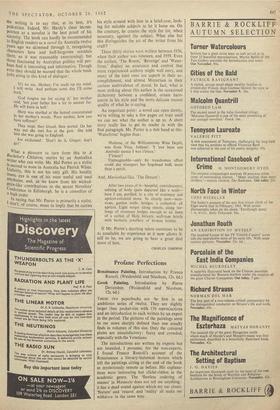Profane Perfections
Renaissance Painting. Introduction by Franco Russoli. (Weidenfeld and Nicolson, 12s. 6d.)
THESE two paperbacks are 'he first in an ambitious series of twelve. They are slightly larger than pocket-size with 176 reproductions and an introduction to each written by an expert in the period. The pictures of the paintings seem to me more sharply defined than one usually finds in volumes of this size. Only the coloured plates are unsatisfactory: fuzzy and crowded, especially with the Venetians.
The introductions are written by experts but are intended, I presume, for the non-experts. I found Franco Russoli's account of the Renaissance a Literary-historical lecture which left the paintings sitting at the end of the book as mysteriously remote as before. His explana- tions were interesting but cliché-ridden in the academic genre. The 'flawless ordering of masses' in Masaccio does not tell me anything : it has a dead sound against which my ear closes. `Nature' and 'reason' and 'reality' all make me withdraw in the same way.
Perhaps Signor Russoli, who is director of the Brera Gallery in Milan, suffers, as we all do, from a loss of total involvement in Renaissance painting. So much, today, holds only the xsthetic attraction of 'design' which we separ- ate from the whole and self-consciously ap- preciate. The full painting does not charge our whole consciousness, only the 'design' part which reaches a perfection in the wholly static work of Francesca. One rarely sees a Messina or a Signorelli and never a Raphael on the walls of a modern flat. Design is all-in-all, and design is essentially non-human. It does not need human beings except as an abstraction. They are messy and untidy. So we move un- consciously away from the sources of the Renaissance to those painters who knew pro- foundly that they stood at the end of a cycle and not at the beginning: 'the sunset that all Europe mistook for dawn,' as Victor Hugo called the Renaissance. We feel in the Mona Lisa that this has happened, that she is not re- mote as the medixval and early madonnas were remote but deliberately made remote by man : an idealisation of secret allurement which depends on its inaccessibility for its power. Even da Vinci's rocks are putty rocks. Compare them with Masaccio's! Even her distortion into an isosceles triangle is a wilful attempt at per- fection which is geometric and non-human.
It is strange, uncanny, how this development is paralleled in Greek painting. Pierre Devambez has written an introduction which makes one look at the work with a fresh awareness, with some idea of what their total impact must have been. He is not as piously reverent to his sub- ject as Signor Russoli : 'The only two epochs in which one has the impression that the Greeks were painters, rather than primarily draughts- men, are right at the beginning and right at the end of the history of Hellenic art.' Before the Doric invasion, that is (the publishers should do a volume of the Cretan frescoes), and during the Hellenistic period. But the later period never equalled the spontaneity of the first, and the intervening centuries M. Devambez (who is curator of Greek and Roman antiquities at the Louvre) describes as 'a resolutely abstract art form, a kind of intellectual geometry, informed by a deep revulsion to all organic form.' It was not until the eighth century BC that the human figure began to be used again, on funeral vases. Perhaps it will happen again.
JOHN DANIEL















































 Previous page
Previous page